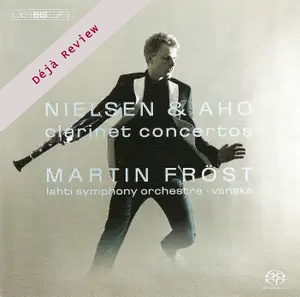
Déjà Review: this review was first published in June 2007 and the recording is still available.
Carl Nielsen (1865–1931)
Concerto for Clarinet and Orchestra (1928)
Kalevi Aho (b. 1949)
Concerto for Clarinet and Orchestra (2005)
Martin Fröst (clarinet)
Lahti Symphony Orchestra/Osmo Vänskä
rec. 2004, Sibelius Hall, Lahti, Finland (Nielsen); 2006, Church of the Cross (Ristinkirkko), Lahti, Finland (Aho)
BIS BISSACD1463 SACD [54]
Among 20th century clarinet concertos Carl Nielsen’s must be counted as one of the foremost. Copland, Hindemith and Malcolm Arnold No. 2 also spring to mind, all three incidentally dedicated to Benny Goodman and recorded by Martin Fröst a decade ago (BIS-CD-893). The Copland is probably the most frequently recorded but Nielsen also pops up from time to time. My first – and only – recording was the old 78 rpm version, originally on Columbia, with French clarinettist Louis Cahuzac and the Royal Danish Orchestra under John Frandsen. It was re-issued, in harness with some Nielsen symphonies of the same vintage, in a cassette box many years ago and in due time it was made unplayable through the not infrequent state of things called tape salad. If I remember correctly this was the first recording of the work and it was regarded for several years as the definitive one.
From the beginning the concerto was quite coldly received and during Nielsen’s lifetime it was only performed six times, including a private performance. It is moulded in one movement but divided in three clearly discernable parts: Allegretto un poco – a short Poco adagio – and the finale the longest and in itself divided in three parts: Allegro non troppo – Adagio – Allegro vivace. The opening has something of baroque over it but seen through 20th century glasses and it gradually become wilder, more rhythmic and with Nielsen’s characteristic snare-drum providing extra spicing, at the same time reminding us of Nielsen’s time as a military musician. The Adagio has a solemn cathedral atmosphere but with a heavily contrasting central section with insistent rhythms and that snare-drum again, which also appears in the last part, with its frequently shifting moods. Nielsen also gives the bassoon some solo opportunities, as he does the trombone in the flute concerto. It is also in this part that the clarinet has its richest opportunities, both as a warm melody instrument and as lithe virtuoso. After some martial drumming the composition gradually dies away.
Kalevi Aho has for quite some time attracted attention for his compositions of large-scale works, among which are four operas, thirteen symphonies and twelve concertos. The clarinet concerto, which like Nielsen’s is in one continuous movement, was commissioned by Martin Fröst, premiered in London on 22 April 2006 and recorded in Lahti two months later. It starts Tempestoso with aggressive wind chords forming the backdrop to the clarinets virtuoso explorations of the instruments possibilities. A recurring feature is the clarinet’s glissando up to its highest reaches, where high strings take over and bring the music even higher. The cadenza, marked Tranquillo is built on tremolo effects, giving the impression of fluttering wings, giving associations to insects: Insect Life being the title of one of Aho’s operas. The third ‘movement’ is rhythmically intricate and requires virtuoso playing from both soloist and orchestra. Aho points out in the liner notes that it also sets the conductor to severe test, the time signature changing almost every bar. This is highly engaging and accessible music, adrenaline producing. As repose from all the volcanic energy the following Adagio is slow and meditative, very beautiful. The Epilogo, marked misterioso, is also slow, the soloist required to produce multiphonic sounds, evocative, otherworldly and, yes, mysterious. Like Nielsen’s concerto it also fades away, leaving the listener filled with warmth and contemplation.
Having listened to the work twice in two consecutive days I am convinced that this is a major composition which in all fairness should be heard in concert halls all over the world and with Martin Fröst’s fame it certainly will. It isn’t actually difficult music – for the listener. There is so much beauty – and that irresistible energy.
Martin Fröst is a superb player with honeyed tone – or wildly screaming, all the time aided by technique that lets him do whatever the composer wants. Everything sounds so easy and even the fastest passages are executed almost casually. The Lahti Symphony Orchestra under its longstanding principal conductor is a front-rank ensemble and with the composer present during the recording sessions we can rest assured that what we hear is what Kalevi Aho wished. I didn’t even mention the playing in the Nielsen concerto but I can hardly imagine it being better performed. A BIS recording is seldom disappointing sound-wise and having listened to it both in SACD mode and through two-channel headphones I have no qualms about recommending it on sonic grounds.
A clear winner on all accounts and Aho’s concerto is destined to be a standard work.
Göran Forsling




















